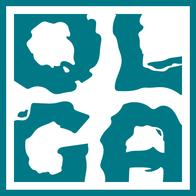OLGA Newsletter No. 2, December 2021
Fresh regional news for Christmas!

HO HO HO! Shortly before the Christmas break, the second issue of the OLGA newsletter arrives in your mailbox. After we had to postpone our focus groups until spring because of Corona, there is once again no Striezelmarkt in Dresden this year and the social get-togethers have been reduced to a minimum. But there is certainly enough time to address the topics of the OLGA project. At home with a cup of coffee, tea or mulled wine and freshly baked Christmas biscuits, it will certainly make excellent reading. And if you still need inspiration for Christmas gifts: check out our 4 edible regional gift ideas! With this in mind, the entire project team wishes you a relaxing Christmas season, many good ideas for regional gifts and a pleasant read!
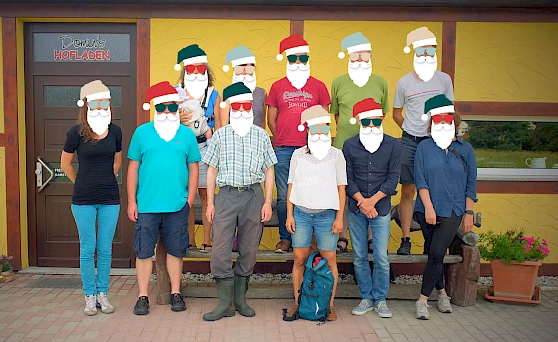
Content
- Can agroforestry structures along watercourses reduce flood risk?
- What's in bloom? Vegetation mapping in and around agroforestry structures
- Nature conservation, climate change, food and agriculture - landscape perspectives in and around Dresden
- Focus groups kick off online: Perspectives for sustainable land use and regional value creation in the Dresden region
- The Green Deal and Saxon agriculture: "Actually, we should only eat bread every day".
- Less is more - sufficiency as a strategy for sustainable urban and regional development
- Upcoming events (in German)
Can agroforestry structures along watercourses reduce flood risk?
Floods are natural events. The starting point is long-lasting, large-scale continuous rainfall or short, heavy rainfall events. When the resulting water masses become too large, rivers and streams overflow their banks and flood the foreland. These floodplains act as natural retention areas that can absorb and hold back large amounts of water. In this case, the vegetation along the watercourses can have a braking effect on the water masses, delay the flood wave and reduce the runoff peaks.
Within the OLGA project, the Institute of Hydraulic Engineering and Technical Hydromechanics at TU Dresden is investigating the extent to which riparian vegetation (including agroforestry structures) can reduce the flood risk in downstream settlement areas. One study area in OLGA is the renaturalised section of the Wiesengrundbach stream in Klingenberg-Colmnitz in the district of Sächsische Schweiz-Osterzgebirge.
The simulation below shows that the agricultural wood plantation established to the left of the road running from the northwest to the south retains the water only minimally and thus does not really serve as a retention area in this case. The reasons for this are the damming of the water to the right of the road, because the Wiesengrundbach crosses underneath it through a pipe, and the deepening of the stream at the level of the plantation.
Contact: Manuel Wewer, TU Dresden, Institute of Hydraulic Engineering and Technical Hydromechanics, manuel.wewer@tu-dresden.de
What's in bloom? Vegetation mapping in and around agroforestry structures
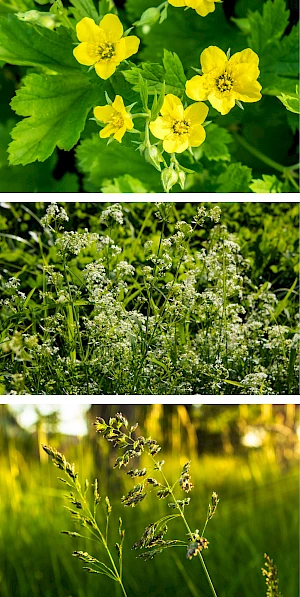
Photos from top to bottom: Animaflora PicsStock, skymoon13, Marco Warm - all stock.adobe.com.
In order to evaluate our study areas at the Peickwitz millrace near Senftenberg (Bandenburg) and at the Wiesengrundbach near Dresden (Saxony) from a nature conservation perspective, vegetation surveys were carried out in the herb layer in early summer 2021. We investigate the influence of the agroforestry plantations on plant diversity and use adjacent reference areas (agricultural areas, marginal, flowering and riparian strips of water bodies) as a comparison. As there is forest in the vicinity of the agroforestry plantations, we extended the study design by five circular survey areas along the transect* agroforestry plantation - agroforestry area - forest and additionally five along the transect agroforestry plantation - agroforestry area/ riparian strip - railway line at the Peickwitz millrace. The aim of the transect analysis is to identify possible dispersal routes of plant species and to find out whether the agricultural wood plantations could be part of a biotope network in the respective landscape context. Railway lines are also relevant for the spread of neophytes.
In total, the species composition and cover was recorded on 55 plots, 25 plots are located at the Wiesengrundbach and 30 plots at the Peickwitz millrace.
In the agricultural woodland plantation at the Wiesengrundbach, a total of 22 species were logged, with common colewort (Geum urbanum) and meadow bluegrass (Poa pratensis) being particularly common and having high cover levels. Almost two thirds of the species are found both in the forest and in the open country.
At the Peickwitz millrace, 19 species could be recorded. Catchweed (Galium aparine) was the most common species with the highest cover percentages. More than half of the species are purely open-land species that occur, for example, in herbaceous vegetation, margins or as field weeds. One third of the species can be found both in the forest and in the open landscape. On the reference areas, the total number of species ranged from 9 (Wiesengrundbach, reference area agricultural area) to 36 species (Peickwitz millrace, field edge).
Further analyses will be carried out in the coming months. We will report on their results in due course.
Kontakt: Michaela Hildebrand, TU Dresden, Chair of Biodiversity and Nature Conservation, michaela.hildebrand@tu-dresden.de
--
*Transect: Along a transect, a marked straight line, data are recorded at fixed intervals. This method is used when you want to establish a spatial relationship to the object of investigation. This method is often used in ecology (botany and zoology), for field investigations (mapping) and in geology and geoecology.
(Source: https://www.pflanzenforschung.de/de/pflanzenwissen/lexikon-a-z/transekt-10152, accessed on 30.11.2021)
Nature conservation, climate change, food and agriculture - landscape perspectives in and around Dresden
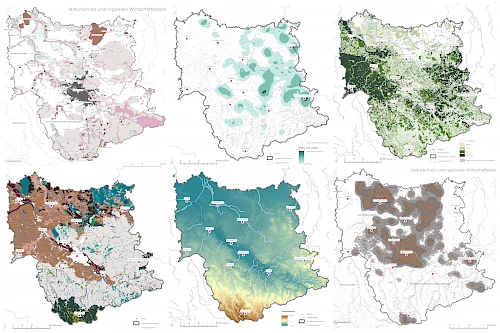
In a comprehensive analysis of the landscape conditions in Dresden and the surrounding area, we look at the region from a variety of perspectives. In this way, we want to explore and visualise the status quo of the landscape, its characteristics, potentials and natural features, in order to identify and implement possibilities for sustainable land use and management. The landscape in a 50 km radius around Dresden is being examined, e.g. with regard to its soil fertility, existing protected areas, natural structure and water body types. The current landscape structure is visualised by means of various thematic maps.
The focus of the analysis has so far been on the natural landscape conditions. Namely, we want to find out how the region has "naturally grown". Currently, the focus is more on the cultural-spatial characteristics and preconditions in relation to the areas of agriculture and food economy as well as nature conservation and biodiversity. What (social) function can orchards or hedgerows, for example, take on in this respect, e.g. as a source of food or as places of recreation? How resilient are agriculturally used areas to climatic changes? And what about land use for (human) food purposes in the Dresden region? We will find answers to these and other questions. So stay tuned.
Contact: Eva Gruhl, Umweltzentrum Dresden e. V. , eva.gruhl@uzdresden.de
Focus groups kick off online: Perspectives for sustainable land use and regional value creation in the Dresden region
After the Corona situation in Dresden and the region has intensified in November, we decided to postpone the OLGA focus groups until spring 2022. Nevertheless, we used the already communicated dates at the end of November and beginning of December 2021 for online exchanges in order to introduce the participating regional actors to each other for the first time and to sketch out initial moods and opinions with regard to the four focus group topics and take up the results for the face-to-face events. Below is a brief summary of the results of the online exchanges:
22.11.2021: Online exchange "Promoting biodiversity through the cultivation of agricultural wood - unrealistic or feasible?"
Knowledge about the establishment and management of agrowood structures in general needs to be communicated more strongly in the Dresden region. Farmers often do not know how to start. The transparent communication of the total costs as well as the ecological advantages of agroforestry use for soil and biodiversity is an important task here. In the end, it must be clear to land owners and users that it is worthwhile to cultivate biodiversity-promoting and multifunctional agroforestry systems which can provide versatile value-added options: from woodchips to the fruits of trees to feedstock for charcoal. This form of land use can also promote certain ecosystem services, but must be designed differently in relation to the respective agricultural system. The funding framework conditions for the realisation of agroforestry systems still need to be created in Saxony. What these can look like in concrete terms will also be the subject of the next focus group event on 25th of April 2022.
25.11.2021: Online exchange "Sustainable land use along watercourses through agroforestry structures"
Analogous to the biodiversity focus group, it was also called for the benefits of agroforestry structures along watercourses to be communicated more strongly. Together with the lower water authorities, the legal hurdles but also possibilities for integrating agroforestry systems into watercourse maintenance measures should be discussed. Farmers who currently still have reservations about planting wood on their land should definitely participate in the focus group. It is important to jointly sketch out a concrete plant design for both the agricultural area and the watercourse edge at the meeting on 28th of April 2022.
30.11.2021: Online exchange "Regionally produced legumes for the local food industry"
The aim is to grow and process more legumes, such as lupins, peas, beans, for human nutrition in the Dresden region together with the Legume Network Saxony. Whether in baked goods, in spreads or simply as a mini snack or lunch dish: pulses are more popular than ever due to their good climate balance, their gluten-free nature and as a vegan protein-rich alternative. Here, too, it is important to convince farmers that cultivation is worthwhile and that the infrastructure for processing is available regionally. Establishing stable value chains and developing new products with pulses are the current challenges here. Young people in particular are thinking more about a healthy, energy-rich diet - products with pulses are very much on the rise. At the presence event on 3rd of May 2022, the important players along the value chain will be represented to discuss new forms of cultivation and value creation options with pulses in the Dresden region.
02.12.2021: Online exchange "Vegetable Pool 3.0 - Securing land for nutritional purposes through regional cooperation?"
How can we secure more land for regional nutrition? Regional planning cannot dictate what exactly the farmer should grow, whether he should cultivate it organically or not or sell it regionally. There are many young farmers who are looking for land to do organic farming. How do they get hold of affordable land? There is a lot of scrambling for land. Most of it is farmed by large agricultural cooperatives. One possibility would be for large companies to give land to young farmers so that farming can be carried out side by side - organically and conventionally. This strategy would also promote diversity in cultivation and varieties. At the focus group event on 5th o May 2022, the participants will jointly consider how they would cultivate a 10 ha field in the immediate vicinity of the event location.
If you are interested in participating in one of the four focus group topics, you are welcome to send us an email to projekt-olga@tu-dresden.de.

The Green Deal and Saxon agriculture: "Actually, we should only eat bread every day".
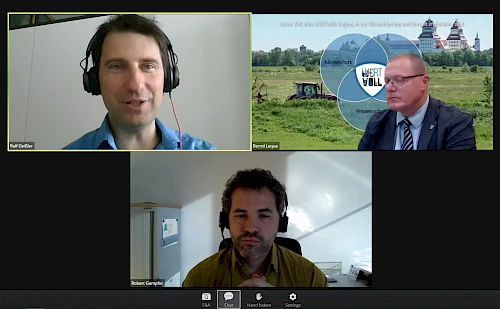
The regional supply of food has long been an important part of urban-rural relations in Europe. However, due to the globalisation of agricultural systems, cities are hardly fed from their surrounding countryside anymore. Alongside this, biodiversity in our landscapes is declining enormously, for which agriculture is seen as the main origin. During the one-hour online discussion of the Europe Direct Centre Dresden in cooperation with the Saxon State Agency for Civic Education on 9th of September 2021, Bernd Laqua, mayor of the municipality of Bennewitz in the Wurzener Land near Leipzig, and Robert Gampfer, Climate and Environmental Policy Officer at the German Representation of the EU Commission in Berlin, together with moderator Ralf Geißler (MDR) spoke about possibilities and ways for more regional value creation and sustainable land use in Saxony.
Mr. Laqua emphasized that despite the increasing number of ecologically and regionally managed farms, the current range of regional products is not yet sufficient to meet the growing demand. According to a survey conducted via chat, almost all of the round 30 participants of the online event would like to see more organic farming with regional value-added cycles. Many farmers have not yet accepted the challenge of converting from conventional to organic farming, said Laqua. This is mainly due to financial reasons, also against the background of the current economic situation. The big question is always: Can I continue to produce and sell with the same effort as before? More and more regional producers are joining networks and sell their products at their "real" price via online platforms such as Marktschwärmer or other regional marketing structures.
Another topic was the draft of the EU's new Common Agricultural Policy (CAP). Here, farmers are to be additionally rewarded for special cultivation methods for climate and environmental protection. 25% of the 1st pillar is reserved for these organic regulations, unfortunately less than expected, but a compromise one can live with, said Robert Gampfer. A central component of the Farm to Fork strategy integrated in the European Green Deal is the creation of more regional cycles in the agriculture and food sector in Europe. In Germany, the same products are produced at a higher price as they are imported. Gampfer called on the retail sector to take action and include more regional products in its assortment. The wider range of products means that people also buy more regionally. Nevertheless, regionally produced products are on average more expensive than others. Due to their tight budgets, many people can only afford food from discounters, most of which is not regional and certainly not sustainable, Gampfer explained. Here, the entire economic system and possibilities for education and information must be taken into account in order to ultimately arrive at sustainable eating habits and systems.
Less is more - sufficiency as a strategy for sustainable urban and regional development
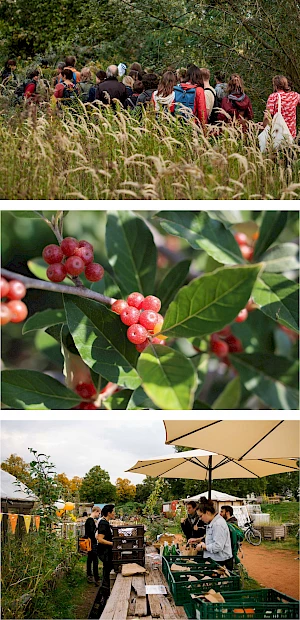
As they say so often: less is more. On 10th of November 2021 within a Stadt Land Plus workshop, we talked about ways in which cities and regions and their inhabitants can become more sufficiency-oriented. Alongside consistency and efficiency, sufficiency is one of the three central sustainability strategies. Sufficiency means reducing the consumption of resources and nature through different behaviour patterns and lifestyles. Accordingly, everyone should ask themselves what is necessary and what is sufficient to live a good life.
Sufficiency-oriented urban and regional development is not that easy. Using less raw materials, more sharing economy, using less space etc. is possible, but often the legal framework and the existing city-regional infrastructure do not allow to act as one would like. However, through good communication and awareness raising, it could be possible in the long term to realise sufficiency-oriented action and decision-making processes in politics, business and administration.
What does sufficiency mean for the agriculture and food industry in the Dresden region?
One scenario: On the production side, a number of small organic farms exist. They are committed to regenerative agriculture and are on the lookout for opportunities for regional (direct) marketing. Consumers are more critical and are taking a closer look at where their food comes from. If you want to know exactly, you can join one of the solidarity farms in Dresden and the surrounding area and actively participate in the harvesting of your food. For more education and communication about more sufficiency-oriented food systems in cities and regions, there are municipal networks such as the Dresden and Region Food Council. It brings together citizens, activists, local politicians and actors from the agricultural and food sector and is the mouthpiece for all concerns in the field of nutrition and regionality. While community catering facilities such as school and company canteens, cafeterias and day-care centres have switched to regional, seasonal and fair-trade products, more and more larger farms have changed their poduction and distribution to organic and regional. What was it again: When demand increases, so does supply?
Regional food projects of the Zukunftsstadt Dresden, such as the "Essbarer Stadtteil Plauen" or "Essbares öffentliches Stadtgrün", cultivate and design small agricultural areas in the city with shrubs, hedges and vegetables together with the citizens. Regular "edible" walks, participatory and educational events take place around the edible on the doorstep. Dresden and the surrounding area have developed into an edible city and region. People know what grows in their immediate surroundings and what they can use for their own nutrition and how.
--
Sources:
BÖCKER et al. (2020): Wann ist weniger genug? Suffizienz als Strategie für eine nachhaltige Stadtentwicklung. München. (accessed on 10.11.2021)
BUND - Friends of the Earth Germany (2017): Perspektive 2030: Suffizienz in der Praxis. Ein Impulspapier. Berlin. (accessed on 15.12.2021)
Upcoming events
- 28.-30.01.2022: 6. Symposium "Aufbauende Landwirtschaft" | mehr Info
- 14.-15.02.2022: Dortmunder Konferenz Raum- und Planungsforschung | more
- 16.-17.02.2022: Stadtlandbio Kongress | more
- 14.-18.03.2022: 4. Darmstädter Tage der Transformation 2022 | more
- 25.04.2022: OLGA Fokusgruppe "Förderung der Biodiversität durch den Anbau von Agrarholz –unrealistisch oder umsetzbar?" | more
- 28.04.2022: OLGA Fokusgruppe "Nachhaltige Landnutzung an Fließgewässern durch Agrarholzstrukturen" | more
- 03.05.2022: OLGA Fokusgruppe "Regional erzeugte Hülsenfrüchte für die lokale Ernährungsbranche" | more
- 05.05.2022: OLGA Fokusgruppe "Gemüsepool 3.0 – Flächensicherung für Ernährungszwecke durch regionale Kooperation?" | more
- 16.-20.05.2022: 6th European Agroforestry Conference, EURAF2022 | more
- 23.-25-05.2022: Dresden Nexus Conference: Biodiversity - stewardship for vital resources | more
Imprint
This newsletter is published by the City of Dresden as the responsible partner for public relations in the OLGA project, which is funded by the Federal Ministry of Education and Research as part of the Stadt-Land-Plus programme.
City of Dresden
Mayor's Office
Dr.-Külz-Ring 19
01067 Dresden
Editor: Anke Hahn | Contact
With contributions by Eva Gruhl, Michaela Hildebrand and Manuel Wewer
If you have not yet subscribed to the newsletter, you can do so HERE.
If you no longer wish to receive the newsletter, you can unsubscribe HERE at any time!
